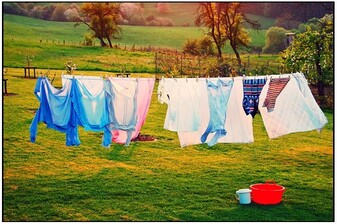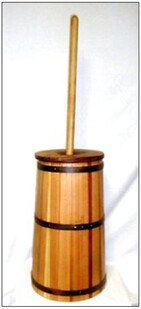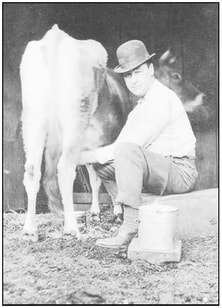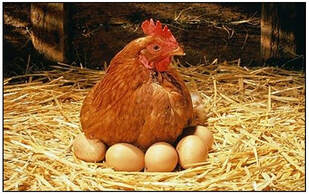A Long List of Chores
By Glynda Pflug

A long list of chores were necessary to take care of a family for the early settlers of Moore County.
Keeping the family clothes clean was a major chore. It involved the mother and all the children. The absence of trees created a problem for finding fuel for the fire to heat the water. It was fifty miles to the nearest coal yard. According to an account by W. J. Morton in Windswept Land, cattle provided "an abundance of prairie coal or prairie stacks, or whatever you want to call it." It made a nice fire, but involved one person putting stacks in the stove, another taking out the ashes, another bringing in the prairie stacks.
Morton said, "Monday was generally wash day. The water was heated in a big cast iron pot and that simple prairie fuel was used to heat it. Boy! That stuff burned in a hurry. This was quite a day around our place. We kids would start out in the morning with our gunny sacks to drag in the fire materials. It took a mountain of that stuff to heat a pot full of water."
Keeping the family clothes clean was a major chore. It involved the mother and all the children. The absence of trees created a problem for finding fuel for the fire to heat the water. It was fifty miles to the nearest coal yard. According to an account by W. J. Morton in Windswept Land, cattle provided "an abundance of prairie coal or prairie stacks, or whatever you want to call it." It made a nice fire, but involved one person putting stacks in the stove, another taking out the ashes, another bringing in the prairie stacks.
Morton said, "Monday was generally wash day. The water was heated in a big cast iron pot and that simple prairie fuel was used to heat it. Boy! That stuff burned in a hurry. This was quite a day around our place. We kids would start out in the morning with our gunny sacks to drag in the fire materials. It took a mountain of that stuff to heat a pot full of water."

"This gunny sack brigade would sometimes get to ratting on the job and let the fire die down, but Mother had some pretty persuasive ways about getting that brigade back into action."
After clothes were clean and hung on the line to dry, everything had to be ironed -- no permanent press items in those days. Early irons, called sad irons, were big slabs of iron with handles that were heated on a fire and used to smooth wrinkles. Later, irons were developed that used fuels like ethanol, natural gas, or oil.
After washing and ironing, there was always some mending to be done. Most was done by hand, as sewing machines were not a common household item.
Keeping the family fed was not an easy chore in the early days of Moore County. Family gardens were the main source of vegetables. Keeping the gardens weeded and watered involved the entire family. Many of the wells would get sand in them and the man of the family would have to work on that problem. He also had to keep the windmill greased and operating. Next, the garden produce would have to be gathered and preserved for using during the winter.
After clothes were clean and hung on the line to dry, everything had to be ironed -- no permanent press items in those days. Early irons, called sad irons, were big slabs of iron with handles that were heated on a fire and used to smooth wrinkles. Later, irons were developed that used fuels like ethanol, natural gas, or oil.
After washing and ironing, there was always some mending to be done. Most was done by hand, as sewing machines were not a common household item.
Keeping the family fed was not an easy chore in the early days of Moore County. Family gardens were the main source of vegetables. Keeping the gardens weeded and watered involved the entire family. Many of the wells would get sand in them and the man of the family would have to work on that problem. He also had to keep the windmill greased and operating. Next, the garden produce would have to be gathered and preserved for using during the winter.

Baking was a major chore, especially keeping bread baked for the family. This involved keeping enough fuel for the stove, so the children were out again with their gunny sacks gathering prairie stacks.
Everyday, the livestock had to be taken care of. Gathering eggs and feeding the chickens was usually the responsibility of the wife and children. Eggs were gathered in baskets or in aprons especially designed with pockets that would safely hold the eggs.
Cows were milked twice daily and part of the milk was used to make butter. Several types of churns could be used. A tabletop Daisy churn would hold smaller amounts of milk. They were glass containers and butter was made by turning the handle on the churn. Other types were large wooden containers with paddles. Butter was made by raising and lowering the handle. the milk, or buttermilk, that was left was separated from the butter and used in baking or for family meals.
The chores that early Moore County settlers had to do everyday involved a lot more work than the same chores do today!
Everyday, the livestock had to be taken care of. Gathering eggs and feeding the chickens was usually the responsibility of the wife and children. Eggs were gathered in baskets or in aprons especially designed with pockets that would safely hold the eggs.
Cows were milked twice daily and part of the milk was used to make butter. Several types of churns could be used. A tabletop Daisy churn would hold smaller amounts of milk. They were glass containers and butter was made by turning the handle on the churn. Other types were large wooden containers with paddles. Butter was made by raising and lowering the handle. the milk, or buttermilk, that was left was separated from the butter and used in baking or for family meals.
The chores that early Moore County settlers had to do everyday involved a lot more work than the same chores do today!
